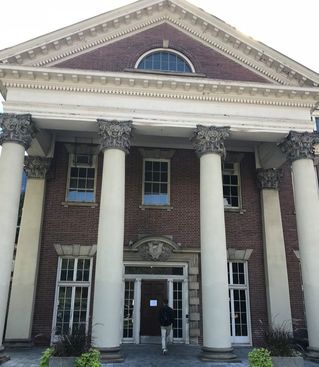Silver Wordsmith: An author's journey |
|
I’m in an introspective mood, which spells trouble for both brevity and comprehension, but in any case, I will try to keep this focused. I’ve recently returned from a conference in Toronto, my first visit to the city since my wife and I moved away seven years ago. In Canada, Vancouver has always been home, but we did spend an amazing three years in our largest city while I attended law school at the University of Toronto. So T-Dot, the Big Smoke, Hogtown, or whatever outlandish nickname you want to give it (Centre-of-the-universe, as those outside Toronto are apt to call it), is a second home. I’m no stranger to having second or third homes. I was born in Budapest and spent many summers there, and I grew up in Moscow, so I’m used to leaving behind places that have been dear to me. But this is the first time I’ve come back to a place after such a long time. Everything changes. Whether people or places, change is woven into the fabric of existence. To expect something to preserve itself exactly as you remember it is to deny that someone or someplace a core part of their nature. Even our Vancouver neighbourhood that we moved into after Toronto has undergone a lot of changes since that time. Stores that had been opened for decades had closed, some being replaced by cannabis dispensaries. A grocery store had a condo tower built on top of it. This all happens so gradually that like the proverbial boiling frog, even though you’re kind of aware of the temperature becoming uncomfortable, the change is just too gradual to truly appreciate.  Then you get dropped into Toronto after a seven-year absence, a city that is known for having two seasons – winter and construction, and pick a random intersection in Downtown and scan your surroundings. The skyline is dotted with cranes erecting ever-higher towers, constantly increasing residence stock without ever alleviating the cost of housing. This never ends, once a building is finished, another one pops up somewhere. So it’s a neat feeling coming across a beautiful light-blue skyscraper, and scratching your head trying to figure out what was there before. But if you can’t remember, it no longer matters, it’s left your life, leaving no impact whatsoever except this vague uneasy feeling that change tends to elicit. Then there’s the stuff you do remember being there. Our local neighborhood No Frills store (probably one of the most “no frills”, as the name implies, grocery stores in Canada) was replaced by a much shinier looking FreshCo. And the old menacing 1960s apartment block that rose above it is now another glass condo tower reaching above its neighbours. This little visual gentrification of St. James Town was a bit of a shock in a city that, as I already mentioned, suffers from an ongoing housing crisis. In the eternal struggle between old and new, I also came across a stark example of a Toronto building strategy – incorporating an old façade into a new building. Heck, there’s a building not too far from the Hockey Hall of Fame that is entirely within what is essentially an indoor mall. So here it is, a clock tower of some unknown historical significance that was chosen to withstand the unstoppable march of progress. Our own apartment building was still there. That was welcome news. The window of our first floor corner apartment, where we spent three years sharing 350 square feet was covered by a clothesline of old towels and sheets. Beyond that impenetrable façade, because how creepy would it be to ask for a tour of the old place, was the first real home we made. Now it’s only accessible through photos and memories, but it’s still there, with the familiar cracks and imperfections we made our own. Which is more than I can say for my second home in Toronto – the law school. Despite getting a whole new building clamped onto its side, from a certain angle, the two law school buildings don’t look any different. The iconic façade we put on all our hoodies and T-shirts is still there – the view at the end of my morning walks. And when you first walk inside, it still hits you with that smell – the history that has seeped into the walls of so many repurposed Toronto buildings.  But then when you exist the foyer, you’re in a whole different world. Sure, Bora Laskin’s bust still sits on its pedestal next to the library’s entrance, but the entrance has moved. The copy stations where I’d print out freshly warm essays to hand in is nowhere to be found. The study nooks on the second floor where I’d eat baby carrots and watch episodes of One Piece are no longer there. I tried to track down any of my old classrooms, but had no luck. Either the new layout has completely messed with my sense of direction or it’s all gone. Photos of graduating classes where you’d be able to pick out half the notable judges and federal Liberal politicians of the last half-century have all been hidden away. My law school, the entity that has awarded me my degree, is still there, but the law school that I truly knew is gone. I would never be able to tell my kids that here is where their mom leaned against that stone pillar while she waited for me and got bronchitis in our first week there. Such a tiny little thing, a silly insignificant story that no longer has the aid of having a live location. Like with the apartment, the memory is there, but the physical space is gone. It shouldn’t really be a big deal but it is. In my early thirties it’s finally creeping up on me. The country I spent the first years of my life is gone. The political ideology that raised my parents is almost extinct. Yet this, a remodeling of a law school is what gets to me. It brings to the forefront the power of memories. People, places, and things all go, but they all live a second life in our memories. We are faced with a flood of photographic evidence. Something our grandparents and even our parents didn’t have. It’s so easy to whip out the phone and observe, but it’s a very different feeling from experience. Now, I’m now trying to turn this into a “technology is bad” kind of luddite rant, but I can’t stress enough the need to appreciate the moment. To truly sink into the people and the places we hold dear to us. I know I’m getting philosophical over some pretty basic stuff, but there’s one thing to know something, and there’s another to truly feel it; deep down in your bones kind of feel it. And this, I feel, is something that is one of the goals of my writing: to turn that inward feeling outward. At the end of the day, I want to leave readers with a memory of the story.
1 Comment
almond
3/9/2022 01:41:36 am
pointless and woke. Waste
Reply
Leave a Reply. |
Michael SerebriakovMichael is a husband, father of three, lawyer, writer, and looking for that first big leap into publishing. All opinions are author's own. StoriesUrsa Major Categories
All
Archives
January 2024
|
Proudly powered by Weebly


 RSS Feed
RSS Feed